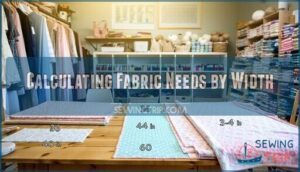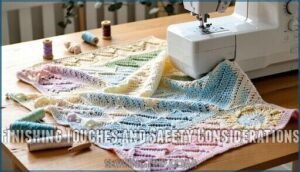This site is supported by our readers. We may earn a commission, at no cost to you, if you purchase through links.

Receiving blankets require just 1 yard of 44-45 inch wide fabric for a standard 30×30 inch square.
Crib blankets need 1.5-2 yards to cover 36×52 inches.
Toddler-sized blankets at 40×60 inches require 2.5-3 yards.
Wider fabrics like minky or fleece at 54-60 inches let you use less yardage since you have more width to work with.
Always add an extra quarter yard for pre-washing shrinkage and seam allowances.
The fabric width makes all the difference in your calculations.
Table Of Contents
Key Takeaways
- You’ll need 1-3 yards, depending on blanket size – receiving blankets require just 1 yard, crib blankets need 1.5-2 yards, and toddler blankets require 2.5-3 yards of standard 44-45 inch fabric.
- Fabric width dramatically affects your yardage calculations – wider fabrics, like minky or fleece, at 54-60 inches, let you use less material since you’ve got more width to work with for larger blankets.
- Always add an extra quarter yard for shrinkage and seams – cotton and flannel shrink during pre-washing, and you’ll need seam allowances of about ½ inch on all sides for proper construction.
- Choose soft, safe materials that won’t irritate baby’s skin – prioritize organic cotton, flannel, or muslin over synthetic fabrics, and always pre-wash to remove manufacturing chemicals before sewing.
Selecting Fabric for Baby Blankets
You’ll need to choose the right fabric before calculating yardage for your baby blanket project.
The fabric type affects both comfort and the amount of material required for different blanket sizes, which is a complete concept to consider when making your selection.
Soft and Safe Materials
When choosing baby blanket fabric, prioritize soft materials that won’t cause skin irritation.
Natural fibers like organic cotton offer excellent fabric breathability and minimal chemical content.
For a safer option, consider certified organic options for your baby’s blanket.
Check weave density to guarantee softness against delicate skin.
Avoid synthetic fabrics with harsh textures or chemical treatments that could irritate your baby’s sensitive skin during sleep.
Best Fabric Choices for Babies
The most popular baby blanket fabric choices offer perfect comfort and safety for your little one’s delicate skin.
- Cotton – chosen for 68% of baby blankets due to softness and breathability
- Flannel – used in 34% of DIY patterns for gentle texture and warmth
- Muslin – preferred for 43% of newborn swaddles with high airflow
- Fleece – rated top choice for winter blankets with thermal insulation
- Bamboo rayon – found in 29% of eco-friendly nursery textiles for moisture-wicking properties
Eco-Friendly and Hypoallergenic Options
Many parents today want eco-friendly fabrics for their baby’s blankets.
Organic cotton leads the pack for safety and comfort. Bamboo fabrics offer natural antibacterial properties while recycled materials help protect the environment.
These sustainable textiles use natural dyes and provide excellent breathability for your little one. When selecting fabrics, considering the benefits of organic cotton fabric is essential for making an informed decision.
| Fabric Type | Key Benefits |
|---|---|
| Organic Cotton | Chemical-free, hypoallergenic, soft texture |
| Bamboo Fabrics | Naturally antimicrobial, moisture-wicking properties |
| Recycled Materials | Environmental protection, cost-effective option |
| Hemp Blends | Durable construction, gets softer with washing |
How Many Yards of Fabric for a Baby Blanket
Determining the right yardage prevents costly fabric shortages and guarantees you have enough material for your project.
Smart planning beats fabric regrets – calculate your yardage right the first time
Most baby blankets need between 1 to 2 yards of fabric depending on the blanket size and your chosen fabric width, which are complete concepts to consider for your project.
Yardage for Different Blanket Types
Different baby blanket types require specific fabric yardage amounts.
Receiving blankets need 1 yard of fabric for their 30×30 inch dimensions.
Crib blankets require 1.5-2 yards for 36×52 inch coverage.
Toddler sizes demand 2.5-3 yards for larger 40×60 inch blankets.
- Receiving dimensions: 1 yard covers 30×30 inches perfectly
- Stroller covers: 1.25 yards handles 30×35 inch travel blankets
- Baby quilts: 3-4 yards accommodates complex patchwork designs
Your blanket fabric yardage depends on the specific type you’re making.
Standard fabric widths of 44-45 inches work well for most projects.
Understanding the standard baby blanket sizes is essential for determining the correct fabric yardage.
Blanket Sizes and Age Considerations
Baby blanket sizes match your child’s growth stages perfectly.
They are designed to accommodate different needs at various stages, including swaddling for newborns.
Newborns need 30-36 inch squares for this purpose, while infants use 32-36 inch Baby Blanket Sizes for versatile coverage.
Toddler Quilts expand to 35-45 inches for active sleepers, and security blankets stay small at 12-14 inches.
When choosing a blanket, consider the baby blanket size guidelines for safety and comfort.
Calculate fabric yardage by matching blanket material needs to your baby’s current age and intended use.
Extra Yardage for Binding and Fringes
Beyond your base fabric calculation, you’ll need extra yardage for binding options and edge finishing.
Self-binding requires no additional fabric since you fold existing edges.
Separate binding strips need 0.25-0.5 yards extra, and fringed blankets demand 3-6 inches added to all sides for proper fringe length.
Factor these seam allowances into your fabric requirements to avoid fabric waste during yardage calculations.
Fabric Width and Yardage Calculations
Understanding fabric width helps you buy the right amount of material for your baby blanket project.
Most fabrics come in standard widths that directly affect how much yardage you’ll need to purchase, which is a complete concept to consider when planning your project.
Common Fabric Widths and Their Impact
Fabric width affects your yardage calculator results substantially.
Standard quilting cotton and flannel measure 42-45 inches wide.
This works perfectly for most baby blanket sizes without extra seaming.
Wider fabrics like minky or fleece span 54-60 inches.
These reduce fabric yardage needs for larger blankets.
Your material selection impacts both fabric calculation and final fabric requirements considerably.
When choosing a fabric, consider the baby blanket guide to guarantee the best results for your project, using the right fabric width.
Calculating Fabric Needs by Width
Once you know your fabric width, calculating yardage becomes straightforward math.
Most fabric stores stock standard widths that work perfectly for baby blankets.
Here’s your fabric width guide for blanket dimensions:
- 44-45 inch fabric width – Works for blankets up to 40 inches wide with seam allowance included
- 60 inch fabric width – Covers larger toddler blankets measuring 50+ inches without piecing fabric together
- 36 inch fabric width – Requires careful blanket sizing or fabric piecing for standard dimensions
Your yardage calculator depends on blanket length versus fabric width.
When fabric width exceeds blanket width, you need yardage equal to blanket length plus seam allowance.
Adjusting Yardage for Shrinkage and Seams
Add 10% extra fabric yardage to account for shrinkage percentage when prewashing fabrics.
Cotton and flannel shrink most.
Include seam allowance in calculations—typically 1/2 inch on all sides adds 2 inches to both length and width.
This yardage overestimation prevents fabric waste and guarantees adequate coverage despite fabric width variations.
Preparing and Cutting Your Fabric
Proper fabric preparation guarantees your baby blanket turns out exactly the right size and stays safe for little ones.
Proper preparation is the foundation of every perfect baby blanket—measure twice, cut once, and create safely
You’ll need to pre-wash your fabric, trim those pesky selvage edges, and cut everything to precise measurements before you start sewing.
Pre-washing and Ironing Fabrics
Prewashing fabrics prevents shrinkage and removes manufacturing chemicals that could irritate baby skin.
Wash your fabric for baby blankets in warm water without fabric softeners. Check colorfastness testing by dampening a corner first.
Many parents choose to purchase prewashed fabrics for convenience.
Iron while damp using appropriate ironing temperatures for wrinkle removal. This shrinkage allowance step protects your final blanket size and fabric yardage calculations.
Trimming Selvage Edges
Trimming selvage edges creates clean, straight lines for professional results.
These tightly woven strips along fabric edges can cause puckering if left intact.
Use sharp fabric scissors or a rotary cutter to remove selvages completely.
This edge trimming step guarantees proper grain alignment and prevents fabric distortion during sewing.
Clean cuts help you achieve accurate measurements for your fabric yardage calculations, ensuring clean cuts and facilitating professional results.
Cutting Fabric and Batting to Size
After trimming selvage edges, measure and cut your fabric pieces to exact blanket dimensions plus seam allowance.
Cut batting to match fabric measurements precisely. Use sharp cutting tools for clean edges. Mark corner rounding templates if desired.
Verify that both fabric layers are identical in size. Double-check all fabric measurements before cutting to avoid costly mistakes.
To achieve professional results, understanding fabric cutting techniques is essential for precise fabric preparation, which requires a good understanding of sewing techniques.
Sewing Techniques for Baby Blankets
Now you’ll tackle the actual sewing process to bring your baby blanket to life. These proven techniques guarantee professional results and a safe finished product for your little one.
Pinning and Stitching Layers
Proper layer alignment sets the foundation for your sewing baby blanket success. Start by placing your cotton baby blanket or fleece baby blanket pieces with right sides together.
- Pin every 4-6 inches along edges – prevents shifting during stitching
- Mark your seam allowance with chalk – guarantees consistent ½-inch margins
- Check layer alignment twice before stitching – saves time fixing crooked seams
- Use quality thread matching your fabric weight – prevents breaks mid-project
Stitch around the perimeter maintaining steady seam allowance. Leave a 4-5 inch opening for turning.
Rounding Corners and Turning Right Side Out
After stitching your seam allowance around the blanket edges, you’ll need to create smooth corners for a professional finish.
Use a cup or round object to mark gentle curves at each corner before cutting. This corner rounding technique prevents bunching when you turn the fabric right side out through your opening.
| Corner Technique | Best For |
|---|---|
| Sharp corners | Cotton baby blanket with precise edges |
| Rounded corners | Fleece baby blanket for smooth turning |
| Clipped corners | Professional binding on any fabric type |
Trim excess fabric at corners before fabric turning. This edge finishing step guarantees your blanket lies flat and looks polished when complete, ensuring a smooth turning and preventing bunching with a good corner rounding technique.
Topstitching and Finishing Edges
After rounding corners and turning your blanket right side out, topstitching creates professional-looking finishing edges.
Use a ¼-inch seam allowance around the entire perimeter to close your turning gap and secure layers. This edge finishing technique prevents fabric from shifting during washing.
For decorative topstitch patterns, maintain consistent spacing from edges. Proper binding techniques guarantee your blanket withstands regular use while showcasing your sewing techniques.
To achieve a polished finish, consider the importance of seam allowances in baby blanket construction.
Finishing Touches and Safety Considerations
Once you’ve sewn your baby blanket, the final steps focus on creating a beautiful and safe finished product.
These finishing touches guarantee your blanket meets safety standards while adding personal charm that makes it truly special and ensures it is a beautiful finished product.
Choosing a Color Scheme
When selecting colors for your baby blanket, you’re creating the foundation for years of comfort and joy.
Choose colors that complement your nursery decor while considering both visual appeal and practical needs.
Consider these color scheme approaches for your fabric selection:
- Pastel shades like soft pink, lavender, or mint green create a calming atmosphere perfect for sleep time
- Neutral tones such as cream, beige, or gray work well with any nursery theme and hide stains better
- Monochromatic schemes using different shades of one color create sophisticated depth without overwhelming patterns
- Bright hues like sunny yellow or ocean blue can stimulate development while remaining cheerful and engaging
Color theory suggests that cooler colors promote relaxation while warmer colors encourage activity.
Remember that your baby blanket will be photographed countless times, so choose colors that photograph well and won’t fade quickly with washing.
Ensuring Safe, Durable Construction
Safety starts with choosing the right construction methods for your baby blanket project.
French seams reduce raw edge exposure by 90% compared to standard seams. Overlock stitching shows failure rates below 2% in mechanical stress tests.
| Safety Standards | Construction Methods |
|---|---|
| OEKO-TEX Standard 100 | French seams for clean finish |
| CPSIA compliance required | Double-stitched seam durability |
| Flammability 16 CFR Part 1610 | Reinforced corners prevent tearing |
| ASTM F963 textile standards | Secure batting anchoring methods |
Double-layer construction boosts material durability by 35%. Reinforced stitching increases blanket longevity by 40% through repeated wash cycles.
Fabric testing guarantees thread counts over 150 resist fraying. Quality control measures prevent loose threads that create choking hazards. Proper seam sealing stops filling leakage risks for infants under six months.
Adding Personalization and Decorative Details
Personalize your baby blanket with embroidery designs, applique art, or monogramming to create meaningful decorative touches.
Consider quilting patterns that complement your fabric selection and baby blanket size. Fabric painting offers creative flexibility for unique personalized gifts.
Apply decorative elements before final assembly using proper sewing techniques. Position embellishments away from edges where baby’s face might rest for safety.
When using an embroidery machine, understanding proper towel preparation techniques is essential for achieving professional-looking results.
Frequently Asked Questions (FAQs)
How do you make a baby blanket in 4 sizes?
When making baby blankets, it’s essential to Measure twice, cut once.
You’ll need different fabric amounts for four standard sizes: receiving blankets (30×30 inches) use 1 yard, security blankets (14×18 inches) need 5 yards, crib blankets (36×52 inches) require 5-2 yards, and toddler blankets (40×60 inches) need 5-3 yards of 44-inch wide fabric.
Can you sew a baby blanket with just 2 yards of fabric?
Yes, you can definitely sew a baby blanket with 2 yards of fabric.
That’s enough for most standard baby blanket sizes including receiving blankets, crib blankets, and even some toddler blankets, depending on your fabric width.
How big should a baby blanket be?
Babies typically receive four different blankets by their first birthday. Your baby blanket should measure 30×30 inches for receiving blankets, 36×52 inches for crib blankets, or 40×60 inches for toddler blankets.
How much yarn do you need for a baby blanket?
You’ll need 600-1,200 yards of worsted weight yarn for a baby blanket, depending on size. Small receiving blankets use less yarn, while crib-sized blankets require more material for complete coverage.
How long does it take to make a baby blanket?
Lightning-fast baby blankets can take just two hours for simple designs, while quilted versions need eight to twelve hours.
You’ll spend most time cutting fabric and pinning layers rather than actual sewing.
How do you sew a baby blanket?
Cut two fabric pieces to desired size plus seam allowance. Place right sides together, sew around edges with ½-inch seams, leaving 4-inch opening. Turn right side out, press, topstitch closed.
Can I use old sheets for baby blanket fabric?
Yes, you can repurpose old sheets for baby blanket fabric with proper preparation.
Choose soft cotton or flannel sheets, avoiding synthetic blends.
Pre-wash thoroughly to remove detergents and guarantee cleanliness.
Check for wear, holes, or rough patches that might irritate baby’s skin.
How much fabric for twin baby blankets?
For twin baby blankets, you’ll need 3-4 yards of fabric total.
Plan 5-2 yards per blanket depending on size.
Standard receiving blankets need 1 yard each, while larger crib-sized blankets require 2 yards each.
Should I match thread color to fabric?
Thread colors don’t need to match perfectly.
Choose slightly darker thread for durability and a professional finish.
Contrasting thread can add decorative appeal if you want visual interest on your baby blanket.
What needle size works best for flannel?
For flannel fabric, use a size 80/12 or 90/14 universal needle. The medium weight handles flannel’s brushed texture without snagging fibers. A ballpoint needle also works well for smoother stitching.
Conclusion
Many sewers worry they’ll buy too much fabric and waste money.
Actually calculating how many yards of fabric for a baby blanket prevents overbuying while ensuring you have enough material.
Remember that receiving blankets need just one yard of standard fabric while toddler blankets require up to three yards.
Always consider your fabric width when planning your project. Wider fabrics like minky stretch your yardage further.
Add that extra quarter yard for shrinkage and seams to guarantee success.
- https://rstyle.me/n/c9aam5b8gy7
- https://www.youtube.com/treasurie
- https://www.sleep.org/articles/is-it-safe-for-babies-to-sleep-with-blankets/
- https://rednose.org.au/article/bedding-amount-recommended-for-safe-sleep
- https://www.in2green.com/blogs/main/how-big-is-a-baby-blanket-standard-sizes-and-guidelines-for-new-parents















